Got the tweeters today and started experimenting.
They were first connected with a 1.3uF capacitor in series with them giving a crossover point of 20KHz. The sound was fairly harsh at the top end, as the capacitor is giving 6dB attenuation at 10KHz which isn't that much with such a high SPL of the Daytons.
I tried various resistor networks to attenuate the tweeters, but still no good. I am currently listening with just a 1uF cap in series (25KHz crossover), this sounds nice at the very top end, but still a bit bright further down.
I am thinking of creating a Second Order crossover to create a steeper roll off. If I add a 0.072mH inductor across the tweeter and keep the 1uF cap, that would give me a crossover at about 18600Hz and a 12dB attenuation at 9300KHz. Any thoughts?
They were first connected with a 1.3uF capacitor in series with them giving a crossover point of 20KHz. The sound was fairly harsh at the top end, as the capacitor is giving 6dB attenuation at 10KHz which isn't that much with such a high SPL of the Daytons.
I tried various resistor networks to attenuate the tweeters, but still no good. I am currently listening with just a 1uF cap in series (25KHz crossover), this sounds nice at the very top end, but still a bit bright further down.
I am thinking of creating a Second Order crossover to create a steeper roll off. If I add a 0.072mH inductor across the tweeter and keep the 1uF cap, that would give me a crossover at about 18600Hz and a 12dB attenuation at 9300KHz. Any thoughts?
I tried various positions of the tweeter, forward, up, back etc. but it still sounded a little harsh.
The very top end sounds good (probably 15KHz +), but where the tweeter overlaps the full range speaker, it's too loud.
This is why I think it sounds like it does:
Looking at the graphs, at 10KHz, the EL70's are around 85db. If the crossover is set at 20KHz for the tweeter, the -6dB point is at 10KHz, where the tweeter (from looking at the datasheet) will be 92dB (-6dB gives 84dB), at 5KHz (-12dB point) the graph shows 92dB (-12dB gives 70dB). The EL70 has a pretty steady graph up to about 10KHz, then it starts to drop off.
Even when I attenuated the tweeter with an LPad, I still had too much top end. Even with -6dB of attenuation, at 10KHz, the tweeter is still at 80dB (92dB - 6dB attenuation and -6dB from the crossover)
That's why I think making a second order system with a 1uF cap and a 0.072mH would be better as it would have a steeper roll off curve and would match the EL70 better.
The very top end sounds good (probably 15KHz +), but where the tweeter overlaps the full range speaker, it's too loud.
This is why I think it sounds like it does:
Looking at the graphs, at 10KHz, the EL70's are around 85db. If the crossover is set at 20KHz for the tweeter, the -6dB point is at 10KHz, where the tweeter (from looking at the datasheet) will be 92dB (-6dB gives 84dB), at 5KHz (-12dB point) the graph shows 92dB (-12dB gives 70dB). The EL70 has a pretty steady graph up to about 10KHz, then it starts to drop off.
Even when I attenuated the tweeter with an LPad, I still had too much top end. Even with -6dB of attenuation, at 10KHz, the tweeter is still at 80dB (92dB - 6dB attenuation and -6dB from the crossover)
That's why I think making a second order system with a 1uF cap and a 0.072mH would be better as it would have a steeper roll off curve and would match the EL70 better.
Last edited:
Sounds like you are on the right track.
I have since done some experiments with my setup which resulted in me removing the tweeters from my system. I used the graph that I referenced on the previous page of this thread to build a DSP EQ preset to compensate for the EL70's rolloff.
I compared the EL70 + tweeters setup to the EL70 + DSP EQ setup. I tried many different types of music and it was not an easy choice, but in the end I decided to get rid of the tweeters for now because the EQ does just as good of a job (or better) and the tweeters looked like crap as they were.
The EQ is a software DSP 18-band EQ called SuperEQ, which is a default plugin in my music player of choice (DeaDBeeF). It uses FIR filter with 16383 taps, and does not reduce audio quality at all.
I have some caps ordered, and I plan to play with the tweeters more. Perhaps they will end up in another project. I don't know.
I actually decided that if I am going to augment the EL70s with a tweeter, I am going to do a completely new cabinet (either Windermere^2 or Wessex) in an MTM configuration with the CSS ERT-26 between two EL70s, and build a "real" crossover (as designed by member DaveR).
I have since done some experiments with my setup which resulted in me removing the tweeters from my system. I used the graph that I referenced on the previous page of this thread to build a DSP EQ preset to compensate for the EL70's rolloff.
I compared the EL70 + tweeters setup to the EL70 + DSP EQ setup. I tried many different types of music and it was not an easy choice, but in the end I decided to get rid of the tweeters for now because the EQ does just as good of a job (or better) and the tweeters looked like crap as they were.
The EQ is a software DSP 18-band EQ called SuperEQ, which is a default plugin in my music player of choice (DeaDBeeF). It uses FIR filter with 16383 taps, and does not reduce audio quality at all.
I have some caps ordered, and I plan to play with the tweeters more. Perhaps they will end up in another project. I don't know.
I actually decided that if I am going to augment the EL70s with a tweeter, I am going to do a completely new cabinet (either Windermere^2 or Wessex) in an MTM configuration with the CSS ERT-26 between two EL70s, and build a "real" crossover (as designed by member DaveR).
Last edited:
The very top end sounds good (probably 15KHz +), but where the tweeter overlaps the full range speaker, it's too loud.
It could well be a case that the dayton's dispersio is so much greater than the FR in this range that the percieved brightness is actually from more HF reflections, wider sweet-spot. Why horns/waveguids are so often used for this purpose.
dave
Depending on your room size, I bet Dave has nailed it. You go from a narrow directional 4" to a flaring tweeter and the reflections slap you in the face. Alternatively it could be as you saw, the cross over slope of 6db is to slow. It's kind of what I was mentioning a few posts back to Cogitech that I suspected the biggest difference he was hearing was the 5 to 10khz range because the 6db/oct is still putting out a fair amount.
Don't get to hung up on the +10khz region. I can hear 20khz just fine, but I'm well aware there is not much music to enjoy up there. There's nothing wrong with admitting that. How much music is there from 20 to 40hz? Not much, but I bet you can hear down to at least 30hz so why not bother with it? (Personally I do bother with the bottom octave as I actually think its more important than the top octave).
Don't get to hung up on the +10khz region. I can hear 20khz just fine, but I'm well aware there is not much music to enjoy up there. There's nothing wrong with admitting that. How much music is there from 20 to 40hz? Not much, but I bet you can hear down to at least 30hz so why not bother with it? (Personally I do bother with the bottom octave as I actually think its more important than the top octave).
I tried again with an LPad attenuator to the tweeters and used a single 1uF capacitor for a crossover at about 26500Hz. I attenuated it by 6dB using 3ohm series resistance and 6 ohm parallel resistance. Not too bright now, and sounding very sweet.
Here's the setup, 160 watt power supply and LM4780 amp (Corian sides and 2 inch aluminium angle for the front and back), Derwent cabinets with CSS EL70 drivers and the Dayton ND20FA-6 tweeters:
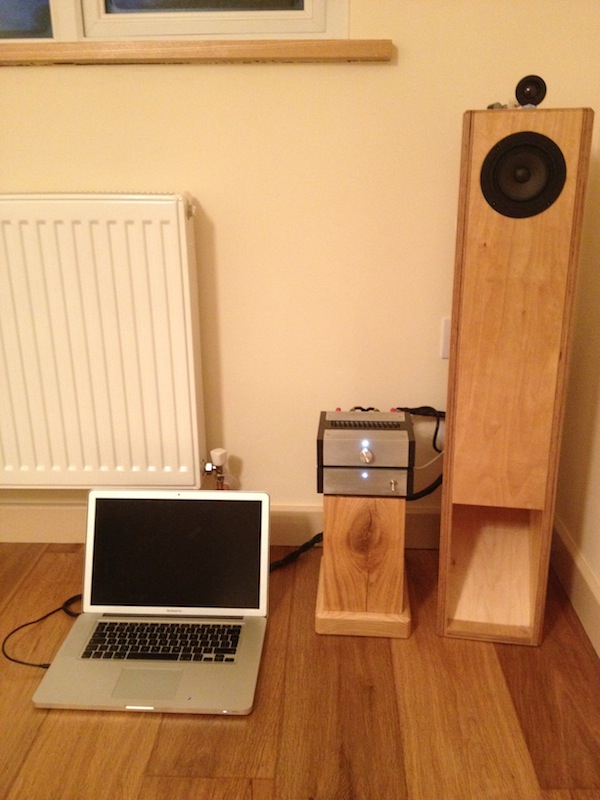
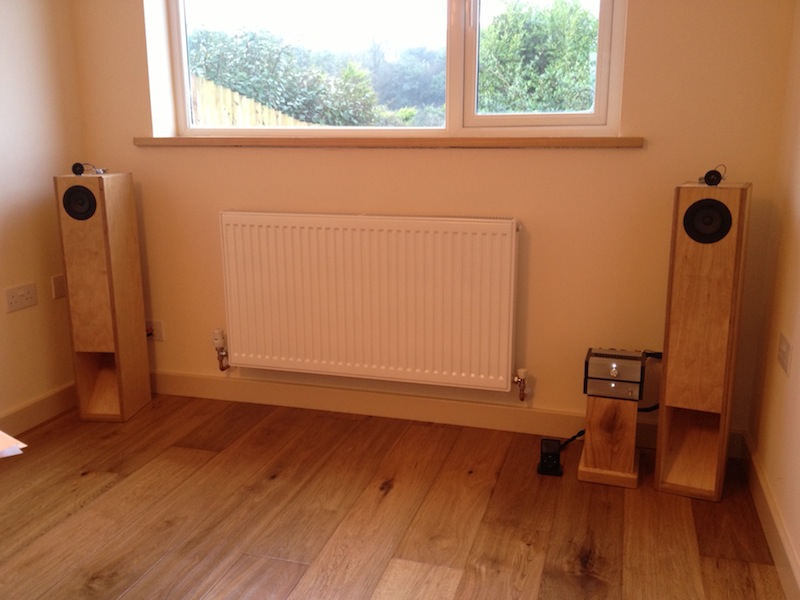
And here is the crossover. I only had some 2 watt resistors to play around with, so I had to parallel them and series them to get the correct resistances. Note in this picture there is a 1uF cap and a .3uF cap, I am only using the 1uF cap now and the sound is very pleasurable:
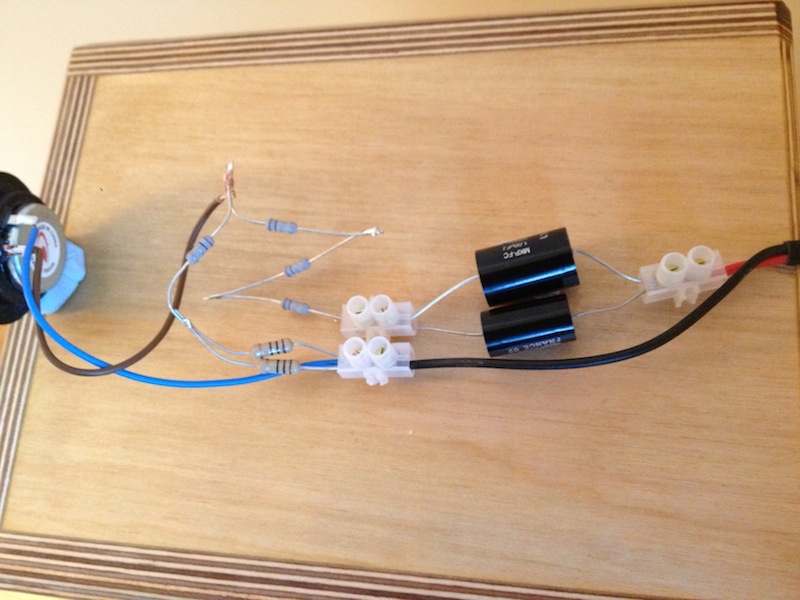
Here's the setup, 160 watt power supply and LM4780 amp (Corian sides and 2 inch aluminium angle for the front and back), Derwent cabinets with CSS EL70 drivers and the Dayton ND20FA-6 tweeters:

And here is the crossover. I only had some 2 watt resistors to play around with, so I had to parallel them and series them to get the correct resistances. Note in this picture there is a 1uF cap and a .3uF cap, I am only using the 1uF cap now and the sound is very pleasurable:
Last edited:
OK. I think I must have got used to the speakers without the tweeters, that's why it seems harsh at the top, but after a few hours listening, I think the sound is better with them. If I disconnect the tweeters, the sound doesn't seem as 'airy'.
I have just ordered some 10W resistors to replace the small ones I'm currently using and to make the order up to get free postage, I decided to get a couple of 0.07mH inductors to get a steeper roll off. I will report my findings when I receive the goods.
I have just ordered some 10W resistors to replace the small ones I'm currently using and to make the order up to get free postage, I decided to get a couple of 0.07mH inductors to get a steeper roll off. I will report my findings when I receive the goods.
Hi Coitech, I am currently building a DAC/Pre-amp. It is the same form factor as the PSU and current amp. All the circuit boards are made and built and tested. It uses a DIR9001 receiver chip and 8 parallel TDA1543a chips. It sounds great. When assembled, the DAC/Pre-amp will have 2 digital inputs, 2 analogue inputs and IR remote switching and volume pot. The volume pot will control my 'lightspeed attenuator' which uses 4 LDRs to control the volume. There's a massive thread about the 'lightspeed attenuator' in the forums and I recommend people building one, very smooth sounding.
While I'm waiting for my resistors to turn up, I started to make my tweeter enclosures.
They are made from the same plywood that my Derwent cabinets are made from. I used a 64mm hole saw to cut out 7 disks. 5 disks have a 32mm hole cut in them. 1 has a 20mm hole and the last has a 38mm hole.
The tweeter will be mounted in one of the 32mm hole disks (widened to 34mm). The disks are stuck together with the 38mm last and the 20mm second to last. The reason for this is I am using a 38mm washer to attach a RCA phono connector and that will sit inside the disk with the 38mm hole and against the one with the 20mm hole.
Enough explaining, here are a few pics:
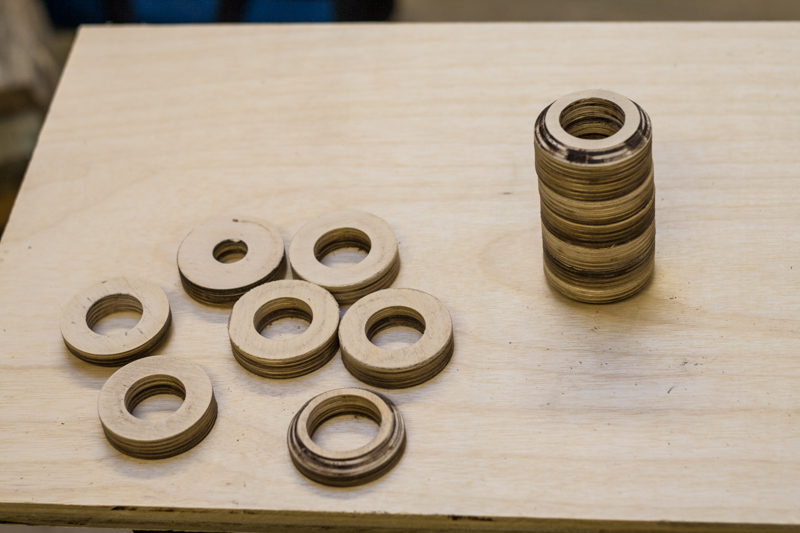
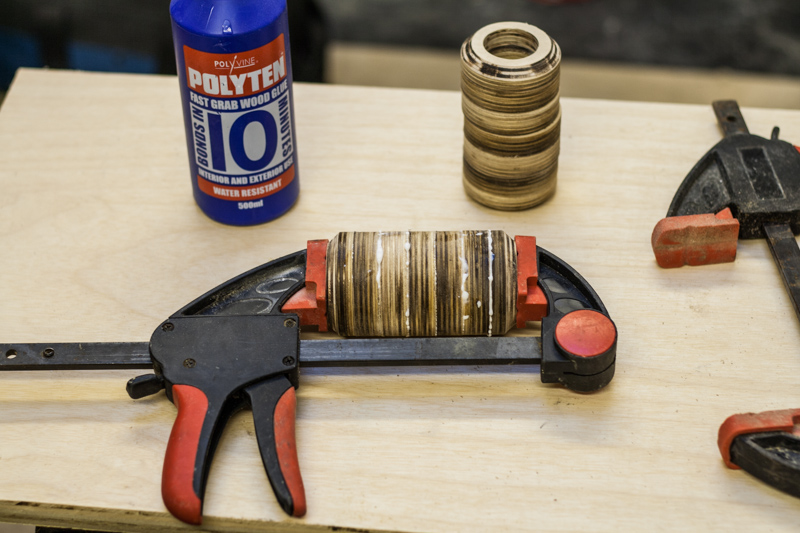
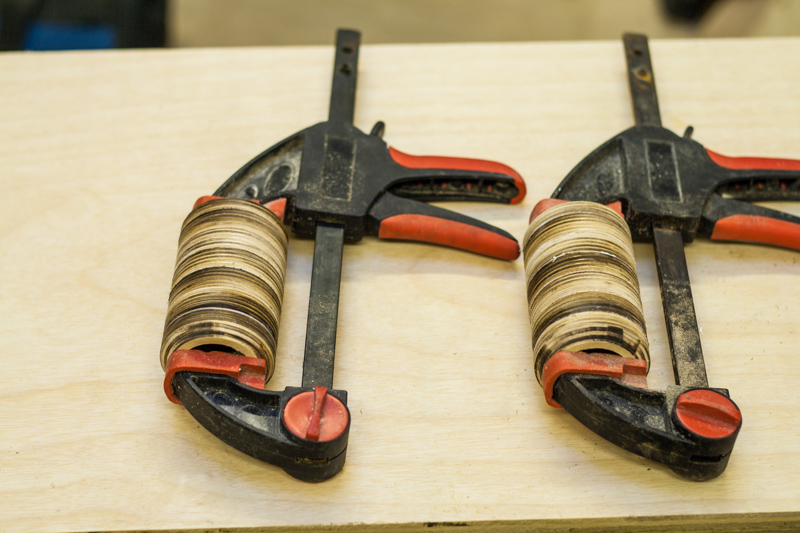
When the glue sets, they will be sanded and treated with Osmo 3032 Polyx oil.
They are made from the same plywood that my Derwent cabinets are made from. I used a 64mm hole saw to cut out 7 disks. 5 disks have a 32mm hole cut in them. 1 has a 20mm hole and the last has a 38mm hole.
The tweeter will be mounted in one of the 32mm hole disks (widened to 34mm). The disks are stuck together with the 38mm last and the 20mm second to last. The reason for this is I am using a 38mm washer to attach a RCA phono connector and that will sit inside the disk with the 38mm hole and against the one with the 20mm hole.
Enough explaining, here are a few pics:



When the glue sets, they will be sanded and treated with Osmo 3032 Polyx oil.
I know this is a discussion thread, but I couldn't resist posting up the pictures of the tweeter housing and the stands:
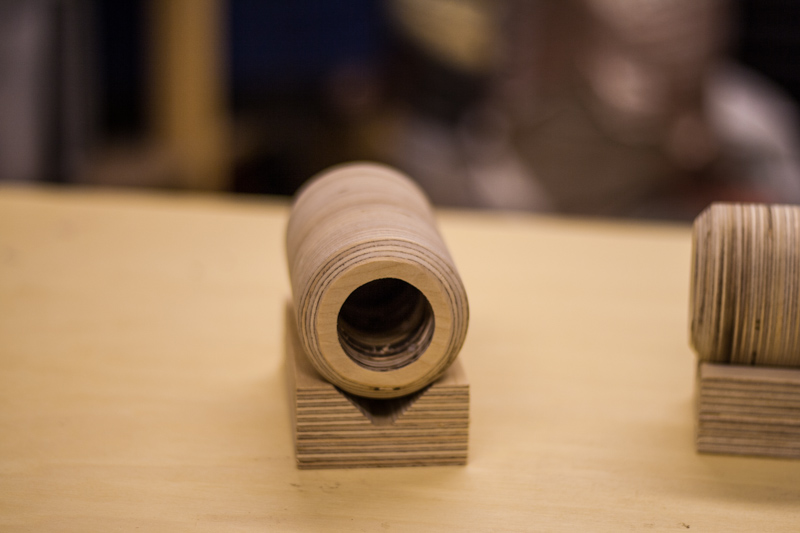
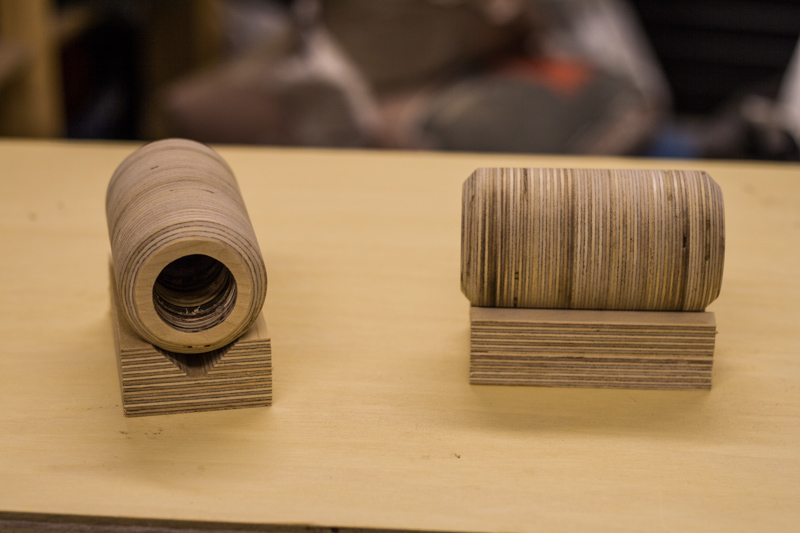
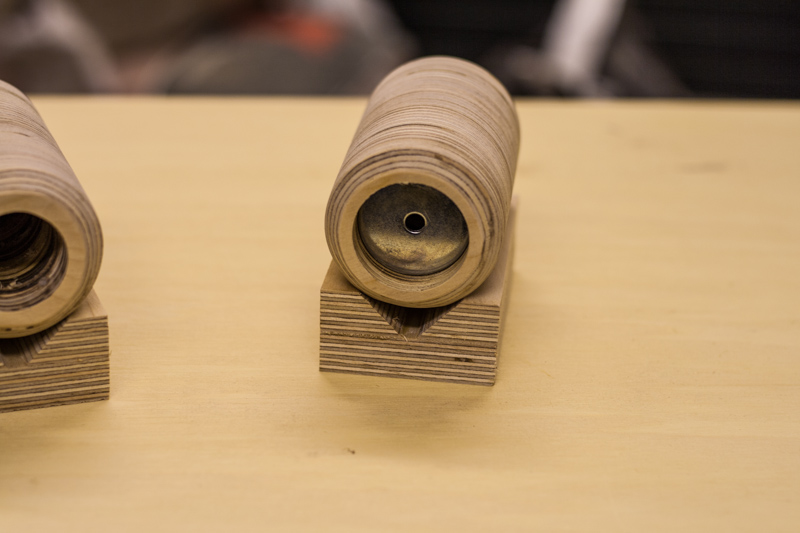
The washer will be secures with screws and the RCA connector will be fixed in the centre.
Just need a bit more sanding and coating with the Polyx oil and then fitting the components inside.



The washer will be secures with screws and the RCA connector will be fixed in the centre.
Just need a bit more sanding and coating with the Polyx oil and then fitting the components inside.
The inductors and resistors I ordered turned up today.
So the set-up I am listening too now, which I feel is the best sounding is 1uF cap and 0.07mH inductor for a second order crossover at 18600Hz with an Lpad attenuator, 3 ohms series and 6 ohm parallel.
When connected the sound seems a lot more 'there', the highs are perfect and not overpowering.
If you listen to just the full range drivers (which I admit sound great in the Derwent cabinets) and then add the tweeters, the sound suddenly opens up. They seem to make the whole tonal range sound better. I would highly recommend getting these tweeters. They are so cheap and the components I added are also cheap, probably spent £40 in total on them.
When the Polyx oil has dried on the tweeter housings I will assemble and add a few pics.
So the set-up I am listening too now, which I feel is the best sounding is 1uF cap and 0.07mH inductor for a second order crossover at 18600Hz with an Lpad attenuator, 3 ohms series and 6 ohm parallel.
When connected the sound seems a lot more 'there', the highs are perfect and not overpowering.
If you listen to just the full range drivers (which I admit sound great in the Derwent cabinets) and then add the tweeters, the sound suddenly opens up. They seem to make the whole tonal range sound better. I would highly recommend getting these tweeters. They are so cheap and the components I added are also cheap, probably spent £40 in total on them.
When the Polyx oil has dried on the tweeter housings I will assemble and add a few pics.
- Status
- This old topic is closed. If you want to reopen this topic, contact a moderator using the "Report Post" button.
- Home
- Loudspeakers
- Multi-Way
- Adding a super tweeter to a full range